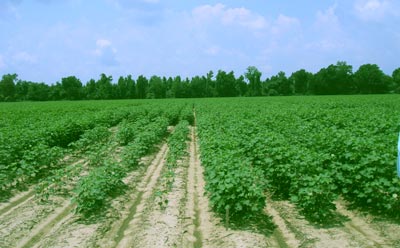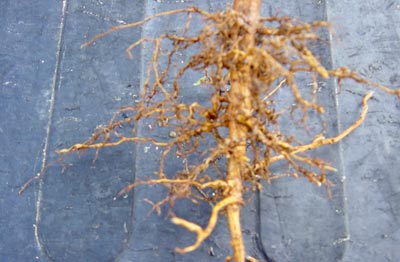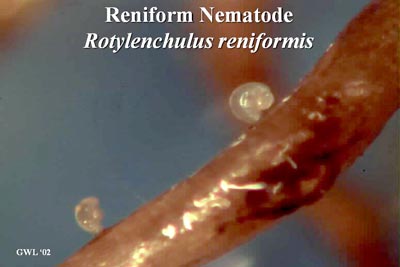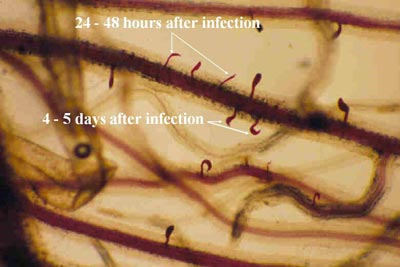Purpose: To build awareness of cotton nematodes in the U. S. cotton producing states.
What are Nematodes? Nematodes are microscopic worm-like animals that feed primarily on the roots of cotton plants. Plant parasitic nematodes punctures root cells with it’s stylet and withdraws nutrition from the host plant.
Plant parasitic nematodes can be sedentary or migratory. They complete life cycle inside roots (endo-parasitic) or outside roots (ecto-parasitic), or a combination of both (semi-endo parasitic). They generally progress through an egg stage and four juvenile stages (J-1 to J-4) before becoming adults. Some species produce eggs by sexual reproduction, while others do not require males to reproduce.
General symptoms. Nematode damage to cotton plants includes stunting, yellowed leaves, wilting, and plant stress. Yield loss may be dramatic.
 |
| Photo by Terry Kirkpatrick |
Where are Cotton Nematodes Found in the U.S.? Plant-parasitic nematodes have been identified in every state where cotton is grown. Cotton nematode species are associated with soil types and climatic areas.
What are the Major Cotton Nematode Species? The major species are root-knot, reniform, lance, and sting nematodes. The root-knot nematode is found across the cotton belt. The reniform nematode is prevalent from North Carolina to Texas, and the lance and sting nematodes are concentrated in the Southeast.
Root-knot nematode (Meloidogyne incognita). It produces galls on roots.
 |
| Photo by Kathy Lawrence |
This nematode is more commonly found in sandier soil types.It is associated with the severity and incidence of Fusarium wilt. This pest maybe found in fields with Columbia lance nematode, but it is infrequently seen in the same fields with reniform nematodes unless corn has been a rotation crop.
Reniform nematode (Rotylenchulus reniformis). It is called reniform nematode, because the swollen adult female is kidney, or "reniform" shaped.
 |
| Photo by Gary Lawrence |
 |
| Photo by Gary Lawrence |
 |
| Photo by Gary Lawrence |
The reniform nematode is more prevalent in the silty soil types. The distribution of the reniform is limited to the warmer regions of the cotton belt. It may increase the incidence and severity of seedling diseases.It is infrequently found in the same fields with root-knot nematode.
Columbia lance nematode (Hoplolaimus columbus). This nematode is called the Columbia lance, because it was first found near Columbia, SC. It may increase the incidence and severity of seedling diseases and Fusarium wilt. This pest is commonly found in the southeast coast region and recently found in Louisiana.
Population Distributions and Densities Maps: The following maps show the locations of three major cotton nematodes across the cotton belt.
For more information, order our free information including Nematode Fact Sheets:
- Root-Knot Nematode Fact Sheet
- Reniform Nematode Fact Sheet
- Lance Nematode Fact Sheet

